A few months after arriving in Australia, Oksana and I noticed something distressing. After a more than a year of hauling big backpacks around the world, nothing interested us more than sitting at home all day. Evenings, weekends – didn’t matter. If we had any free time, invariably our first choice was to spend it sitting on our asses. Understandable, I suppose, but after three months of inactivity, some of our clothes weren’t fitting anymore… and we didn’t have all that many clothes with us to begin with!
It was Oksana who brought up the P90X program and wondered if it was something we could do at home. I’d heard of it before, years ago. I remembered it as an intense workout program designed for people who are already considered “fit” (whatever that means), one that uses small weights and body resistance for most of its exercises. We did some research and I warned her that it would be a very intense program with a large time commitment – at least if we were going to treat it seriously. She said she was game if I was.
So, 13 weeks ago – 90 days ago, to be exact – we started in on the P90X program. Today is our official end date.
Here’s my “before” photo, which they encourage you to take so that you can see your progress (and one which, just so you know, I have a very hard time posting online!)

The after photos are posted down near the end of this entry. Everything else is my thoughts on the P90X program.
What is P90X?
At its simplest, the P90X program is two things: A fitness program and a nutrition plan. Follow their instructions to the letter for 90 days and, they assure you, you’ll be “in the best shape of your life.”
Let’s look at both parts:
The Fitness Program
The P90X fitness plan comes on a bunch of DVDs and is broken down into 12 different exercise routines (plus one “getting started” DVD, which is freely available online.) Every day of the week, you do at least one of the exercise sessions – which last anywhere from 60 to 90 minutes – based on their pre-set schedule.
One of their selling points is that the P90X program is built around “muscle confusion.” Right when your body starts to become accustomed to a particular series of exercises, they switch things up and give you new exercises to do. Because of this (supposedly), you never plateau and therefore continue to build muscle all the way through the program.
No matter your fitness level, some of these exercises are hard. Not only does each session target very specific muscle groups, it hits you with exercises that work the same muscles groups over and over and over again on the same day. Often you’re told to keep doing a set – usually during pushups and pull-ups – until exhaustion… and a few minutes later you’ll be asked to do it again. I don’t care if you’re the Hulk and can do 1000 pushups; your muscles will be just as sore as mine when you collapse on 1001!
Having embarked on weight training routines before (not to mention playing ultimate Frisbee for the first time after a long winter absence from the sport), I knew that the muscle fatigue and pain from the first few days would probably be so bad that we’d be in danger of quitting the program before really getting started. I recommended to Oksana that we sample each of the sessions first – essentially just step through them without using weights.
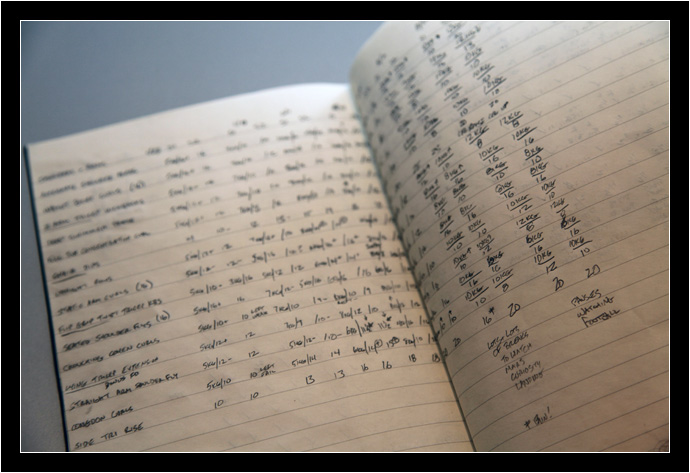
For two or three weeks, we did just that. And it still hurt! I’m not exaggerating when I say that I couldn’t even get through some of the warm up exercises for a few of the sessions (I’m looking at you, Plyo!) I don’t think I made it to the half way point in any of them during the first week. The second week found me giving up at around the two-thirds mark. On the third week – the last week before we actually planned to begin! – I forced myself to step through the full routines, even if that meant pausing the tape while I caught my breath. As humbling as it was, prepping that way was a good idea. We eased into the soreness and it was bearable.
Briefly, here are the exercises and a few comments on each:
Chest and Back
Mostly one hour of bouncing between pushups and pull-ups, without a break. Chest exercises have always come easy (well, easier) for me, so I expected to do okay here. Unfortunately, I didn’t realize how many ways there are to punish the body with different forms of pushups. Standard, Military, Wide, Decline, Diamond, Divebombers. The Diamond was particularly difficult, as you make a diamond shape on the floor with your index fingers and thumbs, and then lower your chest down on top of it before pushing up again.
Plyometrics
While chest exercises are easier for me, Oksana excels at ones that work her legs (it comes from 8 years of ski school when she was a kid.) Plyometrics is “jump training,” working on those fast-twitch muscles. Imagine an hour of jumping around like a rabbit, intercut with lunges and crouches. This was the one that initially killed me on the warm up, going from a deep couch to standing up straight with your arms over your head… 30 times in rapid succession.
A small anecdote about Plyo: About the only thing I remember from the P90X ads I saw years ago was an exercise where you stand in front of a chair and alternate swinging each leg over the back of it for one minute. Swing Kicks, they call them. “I could do that!” I thought. “If the whole program is that kind of stuff, sign me up!”
In fact, the swing kicks aren’t all that hard… by themselves. But when you get to them, they come right after three other cardio-intensive exercises: Jump Squats (squat low, then jump), Run Stance Squats (same thing, different stance), and Airbourne Heismans (hop from one leg to the other, stopping in place at the peak of each.) And then, once you’ve done a set of all four exercises… you do them all AGAIN.
It was a tossup between Plyo and Core Synergistics for the session I dreaded the most.
Shoulders and Arms
Almost every exercise in this session uses free weights (dumbbells.) Shoulder presses, lots and lots of curls, and some tricep presses. Pure weightlifting here.
Yoga X
The longest of the sessions, Yoga X, runs 90 minutes. I never thought much of yoga until trying this program. The amount of strength and flexibility needed to do most of the balance postures was amazing. I’m happy to say that, though I was falling over left and right at the beginning (and quivering in place with muscle spasms when I didn’t), by the end of 90 days, I was able to do almost every one of the exercises.
Kenpo X
The Kenpo X routine is a martial arts-themed cardio workout. Lots of air punches, kicks, and blocks. Surprisingly, the two years of Tae Kwon Do I did almost 20 years ago did a great job preparing me for this routine. Once my cardio had improved enough to get through it, I looked forward to days with Kenpo because it really was easy for me.
Stretch
At least once a week, you’ll have a “rest or stretch” day. I never opted to simply rest, instead always forcing myself to at least do the stretch routine. Still takes an hour out of your day, but it’s very low impact. I’m sure my flexibility has improved because of it.
Core Synergistics
Thankfully, Core doesn’t come around all that often, because it’s freaking hard. Not so much because it targets the core, but because it’s relentless during the session. Superman/Banana, Bow-to-Boat, Plank-to-Chataranga Run (dear God!), Squat Run, Steam Engine, Plank-to-Chataranga Iso… it just never lets up. There’s also a couple crazy styles of pushups in there, too. Sphinx pushups, Prison pushups, Reach High and Under pushups, Walking pushups…
Core and Pylo: The only two routines that, at times, left me laying face down on the floor gasping for air.
Chest, Shoulders, and Triceps
By the time I got to this session (week 5), I thought my pushups had improved. Ha. No. This takes it to a whole new level with Slow-Motion, Fast, Plange, 2-speed Twitch, Side-to-side, Clap or Plyo pushups (seriously, look at this plyo pushup!), 1-Arm Balance, and the dreaded 1-Arm pushups. (The 1-Arm pushups were one of very, very few exercises I was never able to do. I doubt it’s strength-related; I just couldn’t figure out the proper form…)
Back and Biceps
Back and Biceps is a lot like the Shoulders and Arms routine, only it’s targeting just the biceps with free weights. Interspersed with lots of pull-ups, of course. Wide, Reverse, Switching, Towel, and Corncob. You know, all those things you can do with a chin-up bar that you’ve never considered before.
Ab Ripper X
Ab Ripper X is only 16 minutes long. Sounds easy, right? Nope! It may be only 16 minutes, but if you end up doing the entire routine – which took me quite a while to build up to, let me tell you! – you’ll end up doing 11 different sets of crunches, sit-ups, bicycles, and leg raises. Some 450 repetitions, all told.
As if that weren’t bad enough, you do Ab Ripper X three times a week, immediately after the weight training sessions.
Cardio
The Cardio routine is a quick 45-minute fat burner. Though it’s not recycled content, it is made up of exercises you see elsewhere in the program (a little yoga, kenpo, plyo and core.)
Cardio is the one routine that is actually ignored in the “normal” P90X fitness schedule. It was included for people who are less interested in putting on muscle and more focused on losing weight. There are also instructions for adding cardio on top of the other exercises, which they call the “Doubles” program. I did Doubles for the last phase, which I’ll talk about later on.
The Nutrition Plan
…has the feel of a tacked-on, poorly thought-out addendum to the fitness program. We tried to make it work, but after two or three confusing weeks of wrestling with the many contradictions within it, we gave up and created our own diet plan.
The P90X program actually has two ways to monitor your food: By meal or by portion. The meal plan, for instance, gives you a bunch of preset menus and recipes and expects that you plan your meals that way. The portion approach seemed more flexible to us, so that’s what we decided to do. Very basically, you could reduce it down to a bunch of checkboxes. Eat this many protein foods, this many dairy, this many carbs, and check off a box for each when you do. When you run out of boxes, you’ve run out of food for the day.
The surprisingly thing for us – and this really did blow me away – was the quantity of food we were not only allowed to have, but were encouraged to eat! Thinking this was a going to be a diet – as I did, before we began – was the wrong way to look at it. It was a nutritional program designed to give your body the energy needed to get through the workouts and recover from them afterwards.
For example, let’s take the Phase 1, “fat shredder,” diet plan intended for me (and my body weight):
7 Proteins (100 calories each)
3 Dairy (120 calories each)
1 Fruit (100 calories)
4 Vegetables (50 calories)
1 Fats (120 calories)
1 Carbs (200 calories)
3 Condiments (50 calories)
and 3 snacks: A “double,” a protein bar, and a recovery shake (100 calories, 200 for double)
My target was 2,400 calories for the day and it didn’t take me long to realize that I was going to have a hard time eating all that food! Oksana and I both had to adjust to things we weren’t used to, like eating every two hours (otherwise we’d wind up needed to consume 1400 or some other ridiculously large number of calories for dinner.)
Still, that’s a good thing, right? It’s hard enough sticking to an exercise program, let alone a calorie-deficit diet, too. We cut out almost all sweets and fats from our diets, instead substituting flavored fat-free yogurt for dessert. We at tons of protein. Grilled chicken breast, Virginia ham, oven-roasted turkey breast, and fish became our go-to meals throughout the day. The results were subtle, but reassuring. Oksana was the first one to notice, after a couple weeks, that she was no longer sleepy in the afternoons. At all.
I had never eaten egg whites or protein shakes in my life, but I turned to them because it was the easiest way to get pure protein into my system without having to eat so damn much. Protein bars became our special treat for the day, but they’re so expensive here in Australia, that it was cheaper to order 12 cases of Cliff Builder’s Bars from REI in the States and pay to have them shipped here. There are constant reminders to down a recovery drink after most exercise routines (and club-you-over-the-head hints on where you can buy the P90X brand) and we looked forward to those, too. We found a powdered chocolate milk drink, Sustagen Sport, on the grocery store shelves here that almost exactly matched the nutritional info of the P90X drink. It really was like drinking chocolate milk, which was a fine reward after a hard workout.
As much as we liked some of the P90X’s diet plan’s effects on our bodies, however, for whatever reason it just wasn’t working for us. We did a lot of research online and chose to do something else that was much better for us in the long run.
The long and the short of it was that we got apps on our iPhones and input everything we ate into them. We were counting calories, yes, but more importantly we were counting grams of protein, carbs, and fats.
Two things were of the utmost importance to us. 1) Don’t exceed the maximum number of calories in a given day (2200, in my case), and 2) Maintain a strict ratio of Protein, Carbs, and Fats. Since we were interested in slimming down (rather than bulking up our muscles), the ratio we were targeting was 40/40/20.
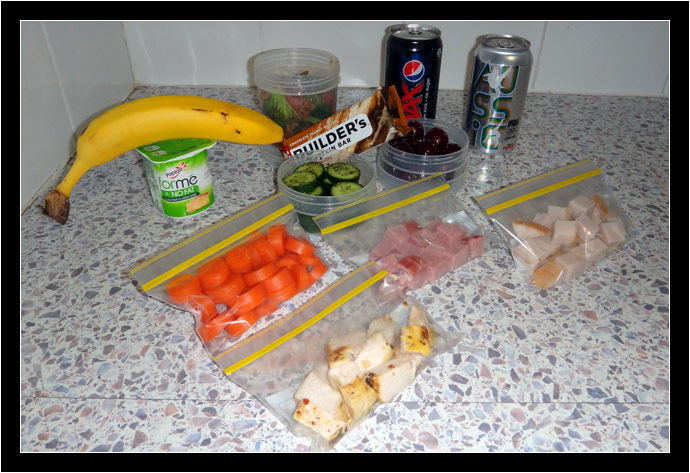
With an app doing all the heavy lifting for us, it was surprisingly easy to maintain the diet. Oksana would prepare her food for the next day after dinner and take it with her to work the next morning. I simply raided the fridge every couple hours. Near dinner time, we’d ask each other, “How are you doing on carbs today?” or “How much protein do you need?” We’d open our iPhone apps and check our Nutrients Pie Chart to see which way we were skewing. More often than not, we’d base or dinner decisions around what we needed to round out our ratios.
It seemed to work far better for us than the P90X Nutrition Plan.
Milestones
Day to day, it’s so hard to see the results from any exercise regimen or diet. I know I’m in better shape now, 90 days after beginning this program, but it’s practically impossible to see the changes on a daily basis. Am I stronger today than I was yesterday? Am I slimmer? If I can’t tell, why am I putting my body through all this, anyway?
Dealing with these thoughts and feelings made me more sympathetic towards both anorexics and those muscle-bound goons who can’t lower their arms. When you can’t see the difference from one day to the next, how do you know when you’ve reached your goal? (Hint: Taking measurements, before and after photos, tracking weights and reps for every exercise; all things that the P90X program encourages you to do!) The hell of it is that you don’t even feel all that much different, either. I mean, objectively I can see that running up a flight of stairs doesn’t wind me as much as it did before, but just sitting around? Or walking to the store? I can’t say I feel any healthier than I did before…
Every so often, however, we notice something about ourselves that confirmed that the program was indeed working. It’s hard to describe how reassuring and encouraging these milestones were. I remember…
…the first noticeable change in musculature, maybe 2 or 3 weeks into the program, was in my front deltoids. One day I just lifted up my arm and noticed that the front of my shoulder seemed… bigger. And not soft. I thought it might have been my imagination, but I asked Oksana if she noticed anything when I did… this, and then I lifted my arm up without flexing. She said, “Whoa!” and pointed right at my delts.
…the first time I got all the way through the Ab Ripper routine. At first, I couldn’t come close to doing all 25 reps in each set. Then, in the middle of week 8, I did them all, but only by pausing the video to rest in between sets. Week 9 was a glorious week, because that was the first time I did the whole routine, all 450 or so reps, without pausing! (It was also a terrible, terrible week, because from then on, I knew I was capable of doing the whole routine. No more slacking!)
…watching my pushups improve. On week one, I was able to do 25 pushups (three weeks earlier, when I was just trying out the program, I only did 16.) At the end of 90 days, I did 52 in my post-fitness test. Even more impressive than that, to me, was the steady progression of almost all pushup types. Here’s a chart:
…the first time I completed the Plyo routine, fully, without pause. Even though my legs were so wobbly that I could hardly stand, even though I was drench head to toe with sweat, even though I couldn’t even whisper a “hurray,” I felt pretty good about that one. Not only because I had collapsed on the floor doing the same routine a week before (which was a good idea, since my heart rate was up at 175bpm at the time), but also because we had walked 12km earlier in the day and I was still able to kill it at Plyo!
…a war of inches fought with Yoga X. Parts of the yoga routine are incredibly strenuous. Fairly quickly I was doing pushups between each of the vinyasas and downward dogs, but the repetitions just wear you out.
Plank, upward dog, pushup, downward dog.
Plank, upward dog, pushup, downward dog, warrior one.
Plank, upward dog, pushup, downward dog, warrior one, warrior two, warrior one.
Plank, upward dog, pushup, downward dog, warrior one, warrior two, reverse warrior, warrior two, warrior one.
Plank, upward dog, pushup, downward dog, warrior one, warrior two, reverse warrior, triangle pose, reverse warrior, warrior two, warrior one…
You get the picture. By the time we arrived at the really difficult poses (like Twisting Half Moon), you could have mixed a can of paint by strapping it to one of my thighs. And, as I discovered sometime on our backpacking trip, there’s a muscle in my lower back (left hand side) that always seems to be clenched up tight. While it doesn’t prevent me from doing any strength training, it did severely limit my flexibility on certain stretches (seated hamstring stretches, mostly.)
By the end, however, there were very few Yoga exercises I couldn’t do. (Crane pose, for instance, I could never really hold for very long – a few seconds at most.) I was especially proud of the times I held Wheel as long as the people in the video.
…when we left town for the weekend to celebrate our 10th wedding anniversary in a fancy hotel. This was the only time we threw our diet plan out the window (and shot it and lit it on fire before it hit the ground), but I made sure the hotel had a fitness center, so we wouldn’t miss a workout. Previously, we had done all our exercises in our living room, without the benefit of a mirror to check our form. As I was going through the warm up routine in front the gym’s big wall-to-wall mirrors, I noticed how defined my calves and thighs had become. Each squat and toe raise brought the muscles out in sharp relief. That was when I decided that Plyo really was worth all that effort…
…when, three weeks before the end of the program, I discovered that there was a weekly pickup game of ultimate Frisbee. I haven’t played in years, but I was very curious to see what the Australia scene was like. Oksana and I walked over to the field one Wednesday night to check it out. We both ended up playing.
I was worried I wouldn’t be able to keep up, but I shouldn’t have been. I ran for an hour and forty-five minutes, matching up with the fastest people on the field – some literally half my age – and never once subbed out. We even played continuous-style at the end.
I had been doing the cardio “doubles” for awhile before the ultimate game, but I was still amazed at how well the P90X program prepared me for a game of essentially wind sprints. I felt goooood out there… at least until it was over and we had to walk 2 miles to get back home. My hips were sore that night and my legs ached most of the rest of the week. Which was to be expected, I suppose. Running works muscles in a very different way.
Failures and Disappointments
I can’t highlight the milestones without at least mentioning some of the disappointments we faced in the program.
- Our apartment doesn’t lend itself well to the installation of chin-up bars. No, not even those ready-made, in-the-doorframe varieties. Which is okay, because the P90X program shows you how to substitute resistance bands for both the weightlifting and the chin-up routines. We bought a set of three bands and, using some nylon webbing from our backpacks, attached them to one of the hinges on our bedroom door. We had just enough room in the hallway to do the substitute chin-up routines.There’s no doubt that we saw improvements when using the straps. I’m sure my back is stronger now, as I can do many more reps than I could at the beginning. Unfortunately, we learned that working with the bands doesn’t translate very well into doing actual chin-ups. When we had access to the fitness center, we used the chin-up bar instead of bands and our performance was disappointing, to say the least. (I was only able to do 2 wide-grip pull-ups and a handful of reverse-grip before I was completely wiped out.) It seems that pulling on resistance bands only make you better at pulling on resistance bands.
- I still can’t do a one-arm pushup, which is especially annoying since I can bang out 50 normal ones without breaking a sweat. (Okay, maybe a little sweat.) Oh, I can do the “modified move,” where you have your knees touching the ground – and I actually saw my reps increase quite a bit on that exercise, too – but it’s just annoying that I can’t get these spindly arms of mine to do even one of the more impressive kind.
- That stupid Crane pose in Yoga! I don’t know if it’s wrist strength or what, but I have a very hard time keeping my body balanced perfectly atop my arms. I tell myself that I could do better if I wasn’t already exhausted from all the vinyasas I’m forced do before that pose comes around, but I’m too scared to try it when I’m rested. What if I still fall on my face? What will my excuse be then?
- Core Synergistics never really got any easier. It may be because they move from exercise to exercise so fast in that particular routine, but it’s more likely because you only get to do Core Synergistics during 3 of the 13 weeks. I don’t think my body ever got used to doing some of those crazy exercises.
- I still don’t have six-pack abs. That was the one thing I really wanted out of this program, too! It’s why I switched diets to eliminate more fat and carbs. It’s why I did the doubles program at the end, adding a second hour to my workout routine four times a week. Oh, I lost a lot of fat, there’s no doubting that, but what’s left is stubbornly clinging to my midsection and it’s stupidly concealing the results of all the core work I’ve done!I’m calling it baby fat. Because it weighs about as much as one.
- Our ten-year anniversary really screwed with our diet. We decided that we were notgoing to calorie count that weekend and just enjoy ourselves. A seafood buffet, trip to McDonald’s, room service, Amarula and ice cream and eggs Benedict for breakfast… let’s just say we went a little overboard. I still logged my food (Oksana was too afraid to do so), and I clocked one day with over 4000 calories. One glorious day.

Once we’d broken the barrier on calories and alcohol once, it was easier to do again later. We went out for hamburgers and a Corona one night with friends. We polished off that bottle of Amarula. Oh, we made it work within the guidelines of our nutritional ratios, but it still felt like cheating.If not for that weekend, we could say that we committed ourselves to the P90X program, wholly, for the entire 90 days. And though we never missed a single workout, as it stands now, we’ll always wonder if our results might have been just a little bit betterif we hadn’t given in to the calories and alcohol… - Mostly, this has been the story of my journey through P90X, but I’ll mention something that Oksana struggled with here. Weight. We weighed ourselves every morning and over the course of 90 days, hers barely fluctuated at all. That isn’t to say she wasn’t seeing some great results! I dropped over 20 pounds in the course of this program, but she was the one noticing that her clothes weren’t fitting any more. Her belt was being pulled tighter and tighter. Really, the physical transformation was obvious as she swapped fat for muscle, but that damn scale wouldn’t budge! We both know we shouldn’t be using the scale to judge our progress, but we just can’t help it. Unlike something as nebulous as “strength” or “endurance,” “weight” is a metric you can measure every day.
Results
Here are some of my “after” photos:

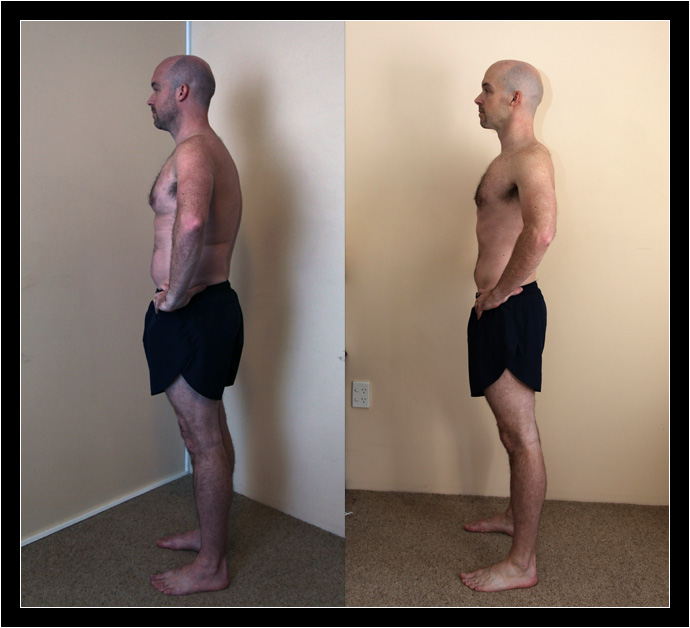
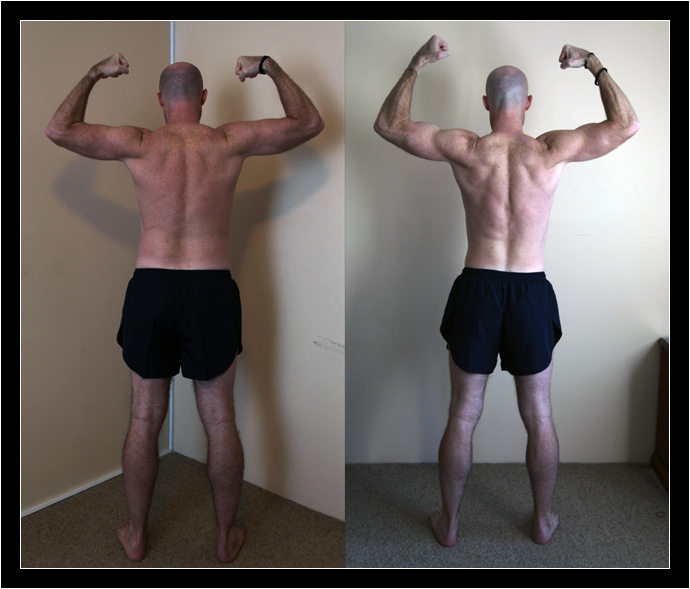

(There are more at the very bottom of this post)
We wanted to do measurements throughout the program, mostly to be reassured that we were making progress. But it’s actually a pain in the ass, so we only did it once about a month in. Here are my starting and ending measurements:
|
Day 1 |
Day 30 |
Day 90 |
|
| Body Fat % |
21.1 |
20.1 |
17.1 |
| Weight |
190 |
184 |
166.4 |
| Chest |
41.5 |
40.5 |
40 |
| Waist |
37.75 |
34.75 |
31.75 |
| Hips |
42.5 |
42 |
40 |
| Thigh (right) |
22.5 |
21.75 |
21.5 |
| Thigh (left) |
22.5 |
22 |
21.5 |
| Arm (right bicep) |
13.75 |
14 |
13.75 |
| Arm (Left bicep) |
13.25 |
13.75 |
13.25 |
| Calf (right) |
15.5 |
15 |
15 |
| Calf (left) |
15.5 |
15 |
15 |
Probably the most visual indication of my progress is in the statistics I copied down after each exercise. I was religious in recording these numbers and always tried to do at least one more rep (or add more weight) than the time before. I hand-wrote them in a notebook, so I can’t easily create Excel pie charts for them all, but I did take the time to input the ones that seemed indicative of my progress. Here again are the pushups:

You can see clear progress in the Ab Ripper routine, too:
And, of course, there’s my weight:

All in all, I’m very satisfied with where the program has taken me. 90 days isn’t too much of a time investment to slim down and put the amount of muscle I have. It would be a great thing to do in the spring, to get ready for a summer wearing a swimsuit.
That said, I wish I had been able to trim off as much body fat as the advertisements and testimonials for the program seemed to indicate I would. (By the scale, I lost 23.2 pounds, but my body fat percentage only dropped from 21.4% to 17.4%. Good lord, what do you have to do to get down to the 6%-10% range that the really ‘cut’ athletes maintain?!)
It may be because I’m not otherwise very active at all. Besides the daily workout routine, I’m basically sitting in front of my computer all day. Or, it may be my age that’s to blame. I just turned 40 and I’m guessing that a person in their 20s would respond better to the exercises. As much as I hate to admit that, it’s probably true.
But, really, I’m not complaining. I don’t know if I’m in “the best shape of my life” at 40, but if I’m not, I’m very, very close.
Lessons Learned
We learned a lot doing the P90X program. Some of what we learned are truly life lessons; I fully believe that the knowledge we gained these past 90 days, about ourselves and about nutrition and exercise in general, will improve the rest of our lives.
Weight
Weight is an incredibly poor indication of progress in fitness. You’d be hard pressed to find a metric that is even close to being as bad. Less you think I’m simply reiterating something I read online, let me assure you that this opinion comes after some extremely precise monitoring of my own food intake and frequent weighings.
With the iPhone app I was using, I can look back over all the food I’ve eaten. I know what my ratios of protein to carbs to fat is for every day. I weighed myself first thing every morning, at the same time, in the same clothes. At first, I couldn’t find any correlation between my weight and the amount of food I was eating, not even when I accounted for the exercising.
How in the world could I have a calorie deficit multiple days in a row (sometimes a rather large one) and yet somehow be gaining weight every morning? The answer turned out to be water retention. Or, rather, sodium levels. Eat a salty dinner, you’ll weigh more in the morning. Doesn’t matter if you burned 2500 calories working out; if you eat a lot of salt – or salty foods – during the day, you’ll put on water weight.
(I tracked 2558 calories burned on the day I played ultimate – a day in which I only consumed 2045 calories – and the next morning the scale told me I had gained .2 pounds! Two days after playing ultimate, I somehow put on 3.6 pounds between one morning and the next. I checked back over my sodium levels and they were normal – perhaps even low. What caused the biggest weight increase I had seen over the entire 90 days? A little research seems to indicate that muscle soreness can also cause water retention…)
I knew that weight is a poor indicator of fitness before this. Yet even now, I’m perversely happy that I lost over 20 pounds in the last three months. Why? I’m pretty damn sure I lost even more than that just by getting sick in Bolivia, and that only took a week. Why can’t I ignore my weight? Why can’t we all? Because we’re trying to see the changes and it’s the easiest of all the physical metrics to measure.
Nutrition
Carbohydrates are consumed for fuel during workouts, protein is for rebuilding muscle afterwards. Fats are great for storing energy for later. That’s a gross over simplification, but close enough for government work when you’re deciding whether or not to decimate that bag of Fig Newtons.
Because we’ve been tracking the amount of protein, carbs, and fat in every item of food we eat, Oksana and I have become much better at gauging the nutritional content of food. We can usually tell, just by looking at a product on a store shelf, if it’s something we want to “budget” into our daily diet. Pancakes? Sure, but no potatoes with dinner tonight, then. Cashews? No thanks, I’ve eaten enough grams of fat today already.
I’ve always known that McDonald’s meals are high in calories, but 550 calories for a Big Mac doesn’t sound so bad if I have a calorie budget of 2400 per day, right? What blew me away, though, was the amount of fat and carbs in both the Big Mac and the fries you’re likely to get on the side. Eating just one extra value meal blew our ratio so out of proportion, we’d have to drink a dozen protein shakes to get it back together!
Not that I’m swearing off McDonald’s, mind you. It’ll always be a guilty pleasure.
I knew we were really getting a handle on our protein/carbs/fats when the iPhone app we were using started to malfunction. At the end of one day, my ratio looked wrong; I couldn’t put my finger on what it was, but it just didn’t seem like I had eaten that many more carbs that protein. Nor did I think my calorie total should have been so high. In reviewing the items of food I’d eaten, I realized that some of the entries had inexplicably changed. The calories count had doubled, the numbers of grams were all wrong. It was incredibly frustrating that the app was broken, but I was impressed that I was keyed into my food well enough to know that the results I was seeing were wrong.
It’s that kind of knowledge that will be useful going forward. Makes picking up a Snickers bar at the checkout line a lot harder, though, let me tell you.
Exercise
Counting calories works both ways. Sure, you count the calories you consume, but you really begin to notice how things work when you also count the calories you burn. Most of the exercise routines in P90X burn anywhere from 400-600 calories. If you walk for a couple miles throughout the day, you burn a couple hundred more. It’s not that hard to offset even an evil McDonald’s meal if you’re doing some sort of exercise every day.
By putting every calorie burning activity into the same app that tracks our nutritional intake, we were able to make informed decisions on what we could and could not eat. That night after ultimate Frisbee? We stopped at Subway on the way home and split a foot-long sub (we could have shared four of them and still been under budget!)
When I was doing doubles, adding a 45-minute cardio routine to my normal workouts, I could have eaten all the desserts I wanted.
Track your calories burned, reward yourself when you do a good job. Don’t exceed your overall calorie budget and you won’t gain weight. It’s as simple as that. (Well, except for the water retention thing.)
Mental vs Physical
This is maybe the most important lesson I learned doing the P90X program.
The hard part isn’t physical, it’s mental.
I’ll bet you that everyone who undergoes a huge physical transformation, whether it’s a dramatic weight loss, buffing up through weight lifting, or running a marathon or whatever… I’ll bet every one of those people made a decision that they were going to stick to it and see it through to the end no matter what.
I did that. I told myself before we began that if I were to going to do this, I was going to do it all the way. No excuses, no cheating, no quitting. Once I committed myself, I’d make myself do plyo at 2am before going to bed if I had to. If I was in pain from my waist down after ultimate (as I was), I would take some ibuprofen – codeine if I had to – and kick my way through the next day’s Kenpo routine.
I never skipped a workout. I did every warm up and cool down. On the days where you’re “allowed” to rest instead of stretch? I stretched. Not because I was physically strong, but because I was mentally strong.
Want to change your body? The only thing you need to be is determined.
Final Thoughts and Recommendations
While the program itself may have a few flaws, the P90X videos are extremely well done. With 12 different videos, there’s enough variety to keep you from getting bored… at least until week 10 or so, by which time you’ve heard every stupid joke a dozen times.
By then, though, your attention will be focused on how well-designed the videos are. A progress bar lets you know exactly how much time you have remaining until the end of each workout. Distinctive sounds announce the beginning and end of each exercise. Timers or rep counters count down until each exercise is over. Even the music is paced exactly right for each exercise to get you into the same rhythm as the instructors. Someone put a lot of work into these videos and it shows.
As much as I would like to recommend the program, it’s not for everyone. You wouldn’t want to launch into P90X from a sedentary lifestyle or if you’re too overweight. There’s a fitness test you can use to gauge if you’re ready, though. It’s a free download. It takes about 40 minutes to complete, but even just looking it over may be enough to tell you if the program is right for you.
Cost
You can pick up the P90X DVDs and fitness/nutrition guides for a little more than $100 (much less on eBay, probably), but there are a lot of hidden costs if you’re planning to do the entire 90 days.
First off, if you don’t already have the exercise equipment, you may need to buy some.
We bought a 20kg (about 40lb) dumbbell set at Kmart for $60. A few weeks later, we went back and bought another set because I needed more weight on some exercises and we were tired of constantly putting on and taking off plates for each exercise.
You’ll also need a yoga mat for, well, yoga, but also for the warm up and cool down stretches. $10.
We bought a set of three resistance bands with comfy handles for $15 or $20.
You might be able to take advantage of a chin up bar, too, but we skipped that. Skipped the optional yoga blocks, too. $10-20.
So, what are we up to now? Maybe $250. Not too shabby.
Hang on to your credit care there a sec, though. There’s more.
The food is expensive. We went from eating cheap packaged crap (not really) to chicken, turkey, pork, lean beef, shrimp, and fish. I don’t have an estimate for you, but our grocery bill definitely went up, up up.
On the flip side, we almost completely stopped eating out and, except for a couple of Coronas and a bottle of Amarula, we didn’t spend anything on alcohol during the same time frame. It could be that that offset the more expensive groceries in our budget and we didn’t spend any more than usual on our food. (We tracked all that, of course, but Oksana hasn’t had time to crunch the numbers yet.)
The biggest expense, by far, was not a monetary one at all. It was time.
The shortest daily routine is an hour long, but most come closer 75 minutes. Getting into workout clothes, pausing the videos to change weights, taking a shower afterwards… it may be safe to assume that 2 hours out your day – all of your days! – will be devoted to the program.
If that weren’t bad enough, there’s the food preparation. Oh, it doesn’t take too long to snack on a couple hundred grams of chicken while you’re doing something else, but it takes plenty of time to shop for it and cook it and prepare it. Even when all the food is cut up and sitting in the fridge, Oksana needs almost half an hour each evening to prepare the food she’s taking to work the next day. Planning and executing a rigorous diet takes a surprising amount of work.
Fortunately, I had plenty of time to devote to such things, although… although… many other things on my to-do list fell by the wayside. Although I haven’t stopped creating things for our travel website, I’ve slacked off greatly. That was in very large part because of P90X. I may only have spent a couple hours a day actually doing stuff for the program, but it was always on my mind. I had a difficult time switching gears to work on anything creative my focus was aimed at getting fit.
And can I take a second here to point out a person who should really be commended for her mental fortitude? Oksana not only did the same program as me, she did it while working full time! On weekdays, she had just enough time to commute to work, come home, do her workout, eat dinner, maybe watch an episode of Breaking Bad, and then go to bed. She rearranged her routine so that the easiest session (Stretch) would come around on Mondays so we could still go bowling or see a movie if we wanted. Sometimes she managed to do the workouts before leaving for work in the morning. Weekends were spent trying to catch up on everything else she couldn’t do during the week.
And she never missed a workout, either. That’s dedication. That’s willpower.
What’s Next?
So what now? That’s a really good question. For one thing, we have to work on our tans. I mean, did you see those before and after pictures?
Seriously, though, Oksana and I are painfully aware that if we don’t maintain the same level of exercise and diet, we’ll rapidly fall back to where we started. On the one hand, that’s so depressing that we’re talking about doing another round (P180X!) On the other hand, after three months, it sure would be nice to skip a few workouts and order a pizza.
For tonight, we’re going out to celebrate! It’s my birthday and we’re not going to worry about exercising or calorie counting or anything like that. We’re going to eat some tasty burgers with our friends and then go check out The Mana Bar – something I’ve wanted to do ever since I first read about it on the Penny Arcade Report.
After that, we’re probably going to take a week off and eat out any time we feel like it. Maybe have some ice cream for dessert when we get home!
Come mid-September, though, I think we’ll be hitting the weights again. There won’t actually be time to do a whole ‘nother round of 90 days, though, because we’re planning to travel around Queensland in November. But maybe we can get in a good six weeks…

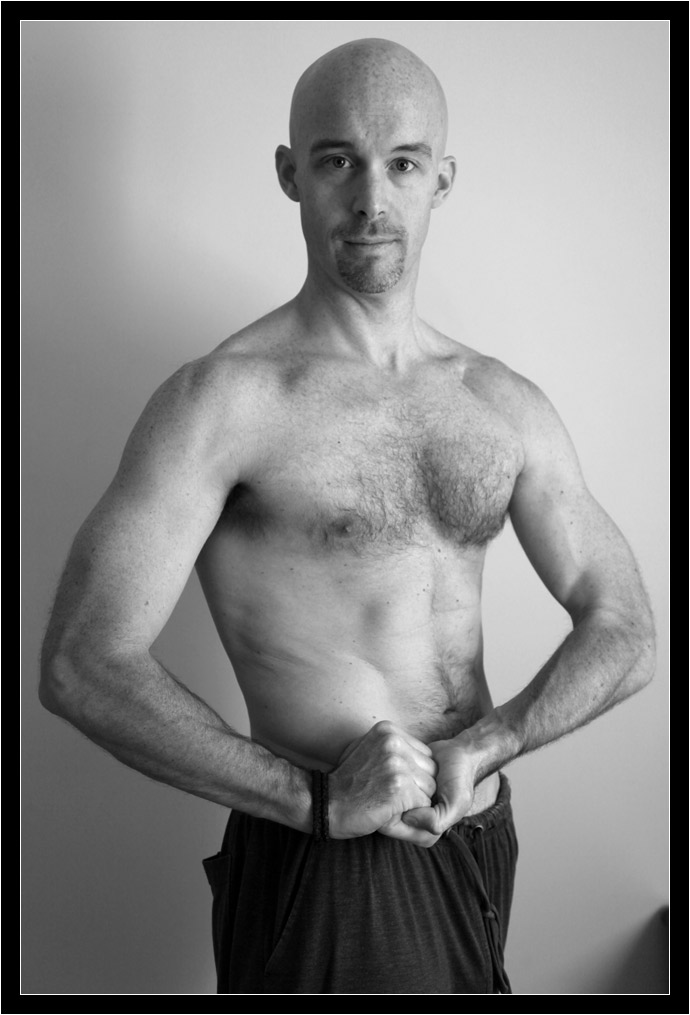
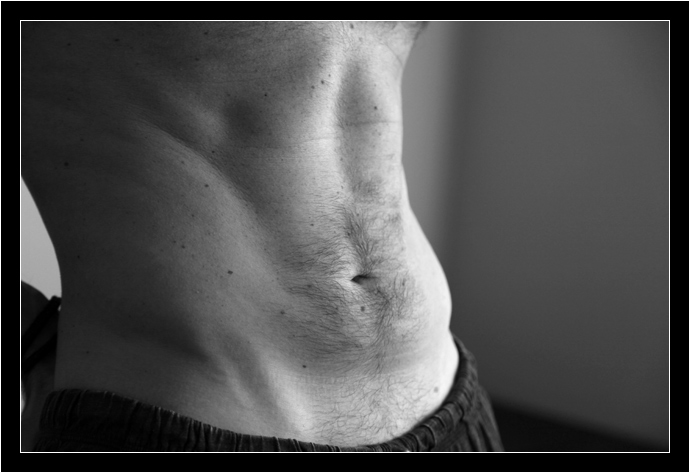



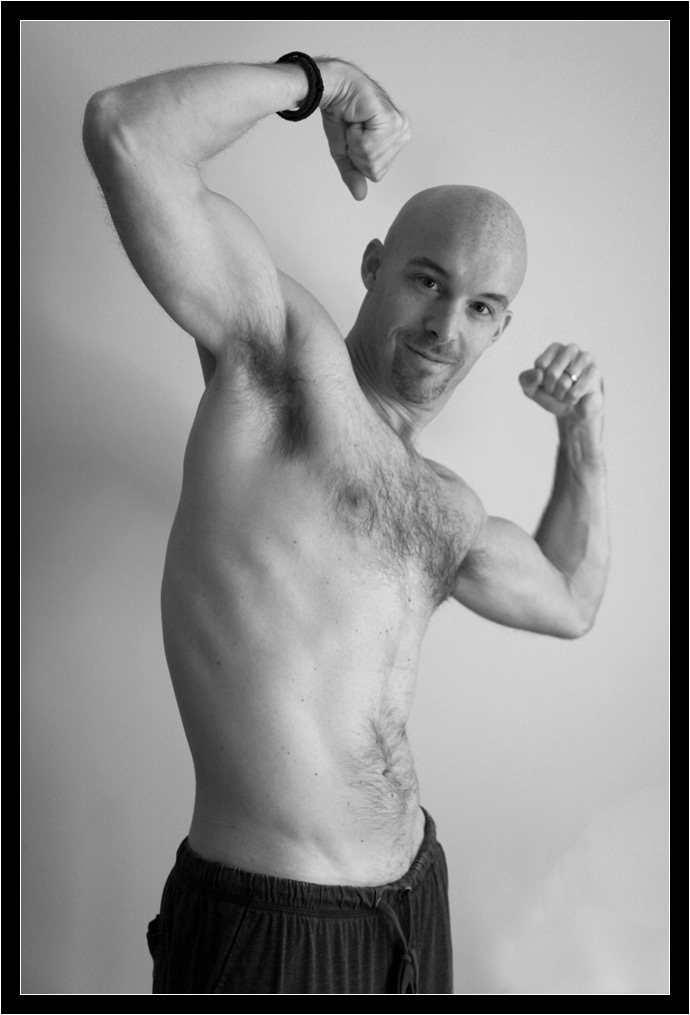
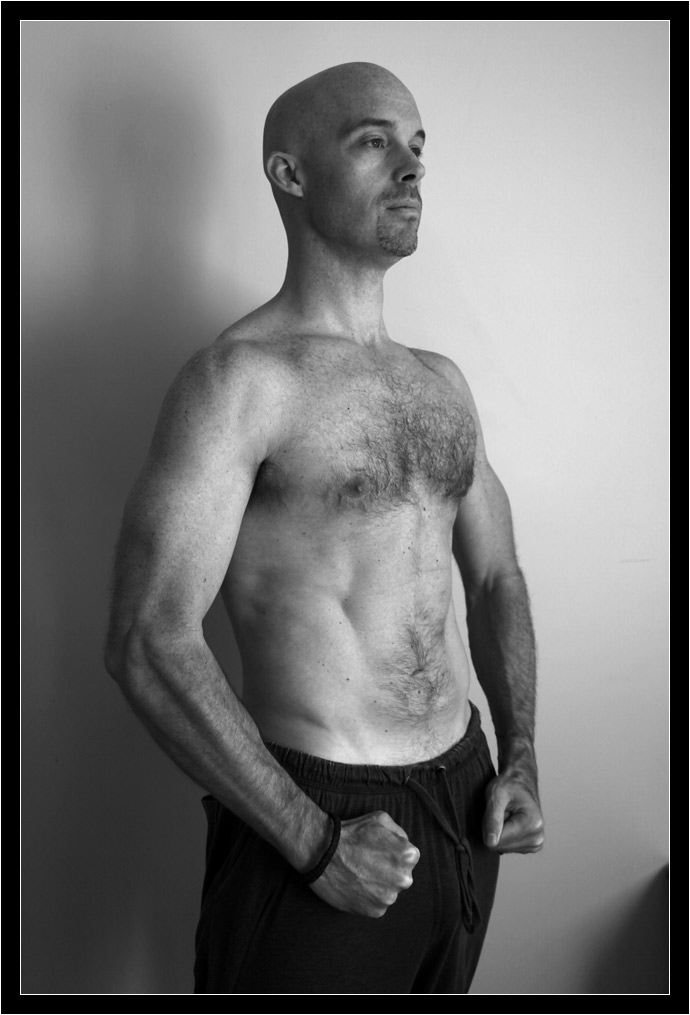




Wow! Arlo you look great. Its amazing you made that much of a physical change in 90 days. Although from the description of the routine I suppose you should have, because it sounded extremely hard!
That’s great you two stuck through it to the end. I’m impressed.
I see you’ve found a new niche as a male model. 🙂
That is really impressive! Well done!
Arlo!!!
What a great and truly inspiring post. Thank you for taking the time to put this out there for us to leach from.
Great pics of you also, seriously!
Brad
Awesome and inspiring! Congratulations to both of you on the exercise, a birthday, and a ten years anniversary!
Hello!
My name is Eduardo and i’m posting from Brazil.
Congrats for the experience and for sharing with us.
i’m in my 2° wek and this thing is as hard as described. Mental power is everything !